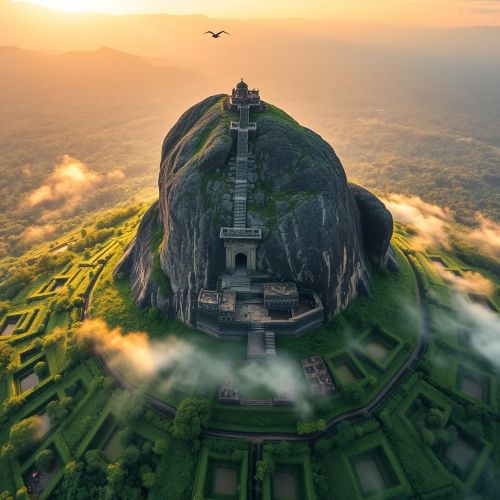Hampi : The Ancient Kingdom Carved in Stone
At a glance
| Description | |
|---|---|
| Mythology | Indian Mythology |
| Country | India |
| Closest airport | Jindal Vijaynagar Airport (VDY) |
| Type | Constructed |
| Accessibility | 10/10 |
Introduction
Hampi, spread across the rugged, boulder-laden landscape of Karnataka’s Vijayanagara district, stands as one of India’s most extraordinary archaeological treasures. Once the magnificent capital of the Vijayanagara Empire, it flourished between the 14th and 16th centuries as a global center of power, commerce, and spirituality. Today, Hampi covers more than 4,100 hectares and is protected as a UNESCO World Heritage Site, celebrated for its breathtaking temple architecture, market streets, royal quarters, and monolithic sculptures. Even in its ruined form, Hampi exudes a sense of lost grandeur—its silent stones echoing stories of kings, deities, artists, and travellers who once walked its pathways. With the Tungabhadra River winding alongside its sacred hills, Hampi remains a living confluence of mythology, history, religion, and natural wonder.
Connection with Mythology
Hampi’s mythological legacy is woven deeply into the Hindu imagination. The region is identified with Kishkindha, the legendary monkey kingdom described in the Ramayana. According to the epic, this is where Rama and Lakshmana met Hanuman and Sugriva, setting the stage for the pursuit of Sita and the alliance that shaped the rest of their journey. The surrounding terrain—marked by caves, rocky cliffs, and ancient shrines—corresponds closely with descriptions from the epic.
One of the most revered locations is Anjaneya Hill, believed to be the birthplace of Lord Hanuman. The hilltop temple attracts devotees year-round, offering panoramic views of the banana plantations, boulder clusters, and the serpentine Tungabhadra River below.
Hampi’s mythic roots extend further through the story of Pampa, the ancient name of the Tungabhadra and the goddess associated with the region. According to legend, Pampa performed intense penance here to win the affection of Lord Shiva. Moved by her devotion, Shiva granted her wish and married her at this very site. This divine union gave rise to names such as Pampakshetra and the title Pampapathi for Shiva. The gods are said to have showered gold during the celestial wedding, inspiring the name Hemakuta Hill, meaning “hill of gold.”
The Virupaksha Temple, still active today, is linked to this mythological heritage, housing Shiva in the form of Virupaksha, a deity revered in the region since at least the 7th century. Numerous carvings throughout Hampi narrate episodes from the Ramayana, Mahabharata, and Puranic stories—such as Krishna’s playful childhood, the Narasimha avatar, and the deeds of the Pandavas—revealing the depth of mythological storytelling embedded in Hampi’s stones.
Ways to Get There
Reaching Hampi is relatively straightforward, although most visitors transit through nearby towns before arriving at the heritage site. The closest airport is the Jindal Vijayanagar Airport in Toranagallu, located about 40 km away, while larger airports in Hubli (160 km) and Bengaluru (350 km) offer wider national and international connectivity. For train travellers, Hospet Junction—just 13 km from Hampi—is the most convenient rail hub, with frequent services from major cities like Bengaluru, Hyderabad, Goa, Hubli, and Chennai. Those coming by road will find Hampi well connected through maintained highways linking it to major South Indian cities, with regular buses to and from Hospet and easy access to taxis, rental cars, and scooters for local travel. The drive through Karnataka’s rural landscape adds an enjoyable scenic element to the journey.
What to Look For
Hampi is vast, and each corner reveals something remarkable. A typical visit weaves together temple architecture, mythological sites, royal structures, and natural vistas.
The Virupaksha Temple stands at the heart of the sacred center, distinguished by its towering gopuram and centuries-old rituals. Nearby, Hemakuta Hill is dotted with numerous ancient shrines, providing wide views of the temple town and the surrounding boulder landscape.
The Vittala Temple Complex is perhaps the most iconic monument in Hampi, home to the legendary Stone Chariot and the musical pillars, known for producing tonal sounds when gently tapped. The craftsmanship of this temple remains unmatched in South Indian architecture.
In the royal enclosure, the Lotus Mahal, Elephant Stables, and the remnants of the Queen’s Bath reflect the grandeur of Vijayanagara’s courtly life. These structures, blending Dravidian and Indo-Islamic influences, showcase the cosmopolitan nature of the empire.
Travellers exploring the mythological landscape gravitate toward Anjaneya Hill, Rishimukha Hill, and Pampa Sarovar, each resonating with stories from the Ramayana. Scattered carvings at temples such as Kadalekalu Ganesha, Pattabhirama Temple, and Lakshmi Narasimha Temple depict scenes of Krishna, Vishnu, and Narasimha, offering insights into devotional narratives celebrated in the region.
Every part of Hampi invites exploration—whether by foot, bicycle, autorickshaw, or a traditional coracle ride across the river—and rewards visitors with layers of legend, artistry, and geological wonder.
Importance in cultural history
Hampi holds a monumental place in Indian cultural history as the epicenter of the Vijayanagara Empire, which rose to prominence in the 14th century and became one of the richest and most influential kingdoms in India. Contemporary travelers from Persia, Portugal, and Italy described Hampi as a bustling metropolis filled with markets, palaces, military camps, and awe-inspiring temples.
The capital city was a sanctuary for Hindu art, architecture, and literature during a period of political upheaval across the subcontinent. Its temples served as centers of music, dance, philosophy, and education, nurturing classical traditions that still thrive today.
The empire’s downfall in 1565, following the Battle of Talikota, led to large-scale destruction. Yet, despite centuries of abandonment, Hampi’s stone monuments continue to stand strong, preserving the artistic and cultural brilliance of a bygone golden age. Today, Hampi is not only a historical site but also an active religious center, with rituals, festivals, and cultural gatherings continuing to animate its sacred spaces.
Best time to travel
The ideal time to explore Hampi is from October to February, when temperatures remain pleasant and the skies are clear. The cool weather makes it easy to trek across hills, roam through temple ruins, and enjoy sunrise or sunset views over the boulder landscape.
The monsoon season transforms the region into lush greenery, though the terrain can become slippery. Summers are extremely hot and generally avoided due to soaring temperatures above 40°C. Visitors arriving in winter can also witness vibrant events such as the Hampi Utsav and Shivaratri festivities at Virupaksha Temple, adding a cultural dimension to their journey.
Source
Hampi. (2003, December 15). In Wikipedia. https://en.wikipedia.org/wiki/Hampi
Mythology of Hampi. (2024, December 31). Hampi.in. https://hampi.in/mythology-of-hampi/
The Myths & Legends of Hampi. (2017, August 6). GoHeritageRun. https://goheritagerun.com/myths-legends-hampi/
Hampi – the magical city of South India. (2018, March 17). Travel and Keep Fit. https://travelandkeepfit.com/hampi/
The Land Of Mythical Landscape – Nomadic Travel Stories. (2016, November 2). Tripoto. https://www.tripoto.com/trip/the-land-of-mythical-landscape-5b938ec0e3dfb
Timeless Places to See in Hampi, Karnataka. (2025, September 22). OnMyCanvas. https://onmycanvas.com/timeless-places-to-see-in-hampi/
Noble House Tours. (2025, June 27). Best time to visit Hampi: Weather, season & timing guide. https://www.noblehousetours.com/best-time-to-visit-hampi-for-amazing-journey/
Route Finder. (n.d.). A detailed guide on the best time to visit Hampi. https://www.routefinder.in/india/karnataka/best-time-to-visit-hampi/
Travel.Earth. (2024, August 8). Best time to visit Hampi, the city of ruins. https://travel.earth/best-time-to-visit-hampi/
Frequently Asked Questions
Why is Hampi famous?
Hampi is renowned for its Vijayanagara-era ruins, stunning temples, and its association with Kishkindha from the Ramayana.
Is Hampi connected to the Ramayana?
Yes. Many locations in Hampi, including Anjaneya Hill and Rishimukha Hill, are linked to events from the Ramayana.
How many days are ideal to explore Hampi?
Two to three days are sufficient to cover its major temples, royal structures, and mythological sites.
Which is the most famous temple in Hampi?
The Virupaksha Temple, dedicated to Lord Shiva, is the most active and historically significant temple in Hampi.
Is Hampi suitable for solo travelers?
Absolutely. Hampi is safe, culturally rich, and easy to explore using local guides, bicycles, or rickshaws.









